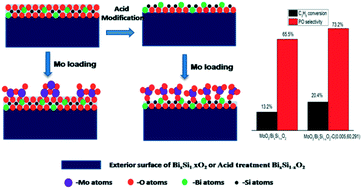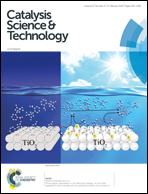The surface construction of Mo–O–Bi coordination for high catalytic performance in gas-phase epoxidation of propylene with O2
Abstract
To solve the issue of facile aggregation of active components and limited synergetic catalysis of MoO3/BixSi1–xO2 catalysts, we highlight an efficient strategy to achieve Mo–O–Bi coordination to fix MoO3 strongly on a surface and improve its dispersion. Incorporating the characterization methods of XRD, N2 adsorption/desorption, ICP, NH3-TPD, Raman spectroscopy, TEM and XPS, the surface chemical and structure properties of BixSi1–xO2 supports with and without modification and the supported Mo catalyst were systematically investigated. Both the dispersion of Mo and the synergetic catalysis of Bi/Mo were restrained by the self-passivated layer of the BixSi1–xO2 support, which led to limited catalytic performance. Mo–O–Bi coordination was achieved by modification of the support in which MoO3 was anchored on the support and monodispersed homogeneous MoO3 was obtained. Based on this approach, the epoxidation activity of the MoO3/BixSi1–xO2 catalyst was obviously enhanced; C3H6 conversion increased from 13.2% to 20.4%, and the selectivity of propylene oxide (PO) reached 73.2%. As such, this strategy may be useful for the preparation of other high performance supported catalysts.


 Please wait while we load your content...
Please wait while we load your content...